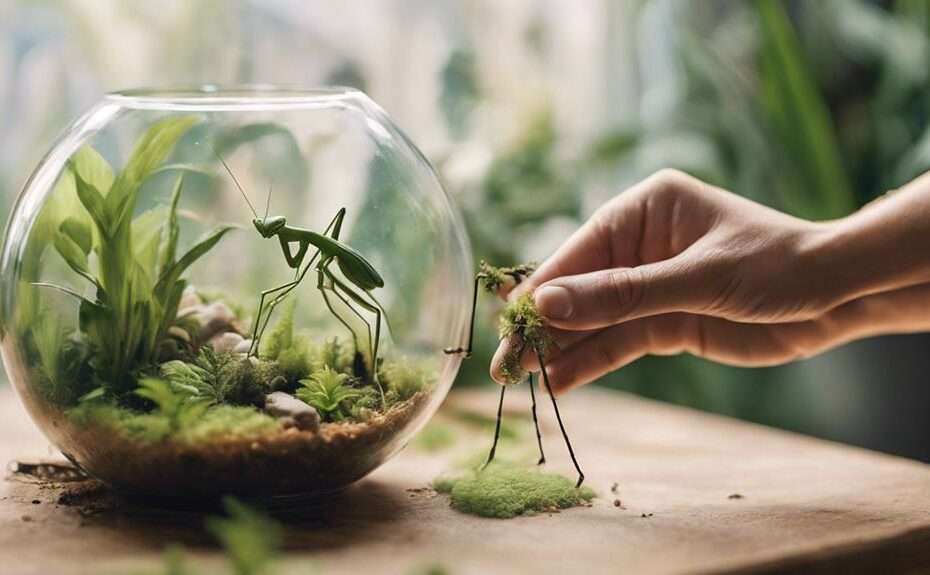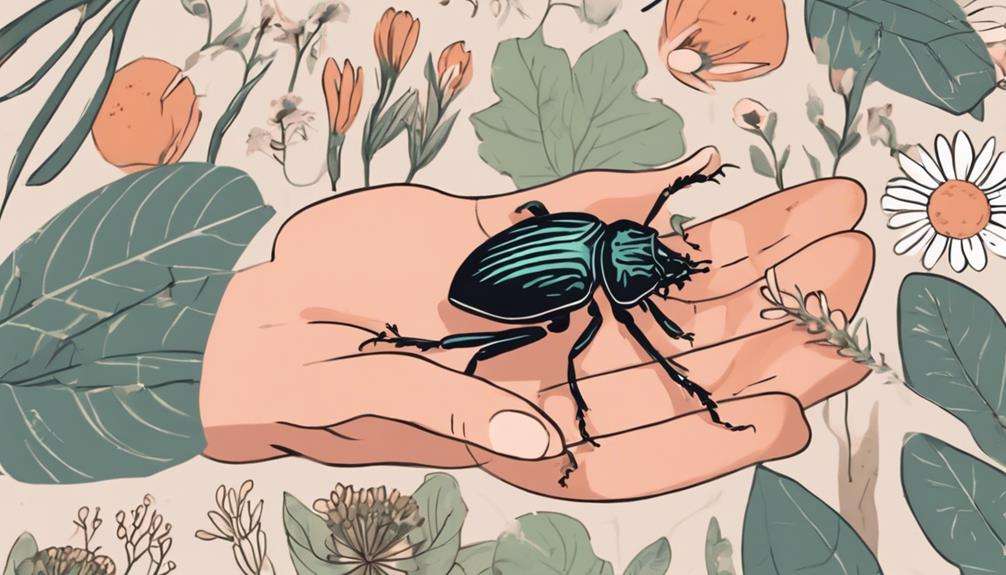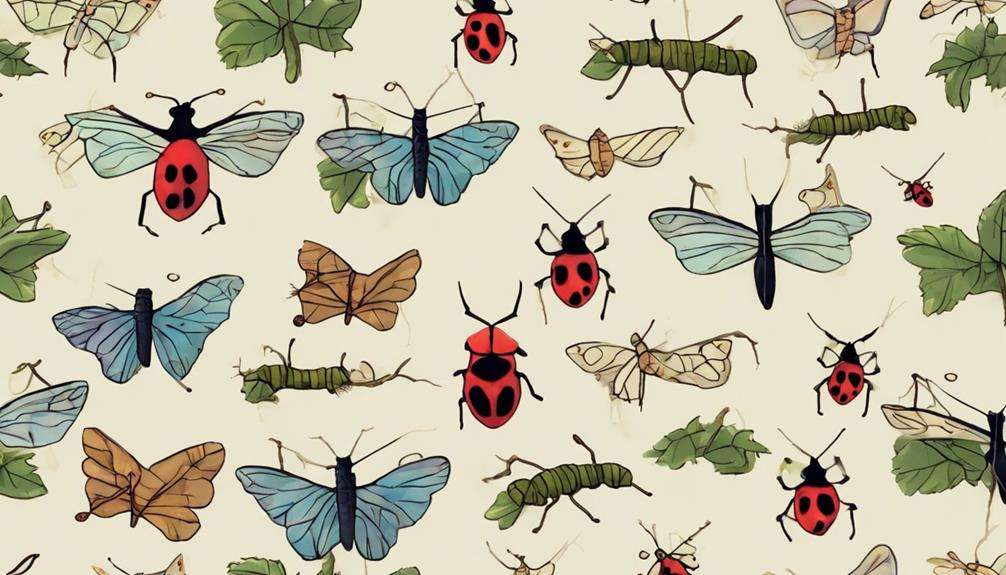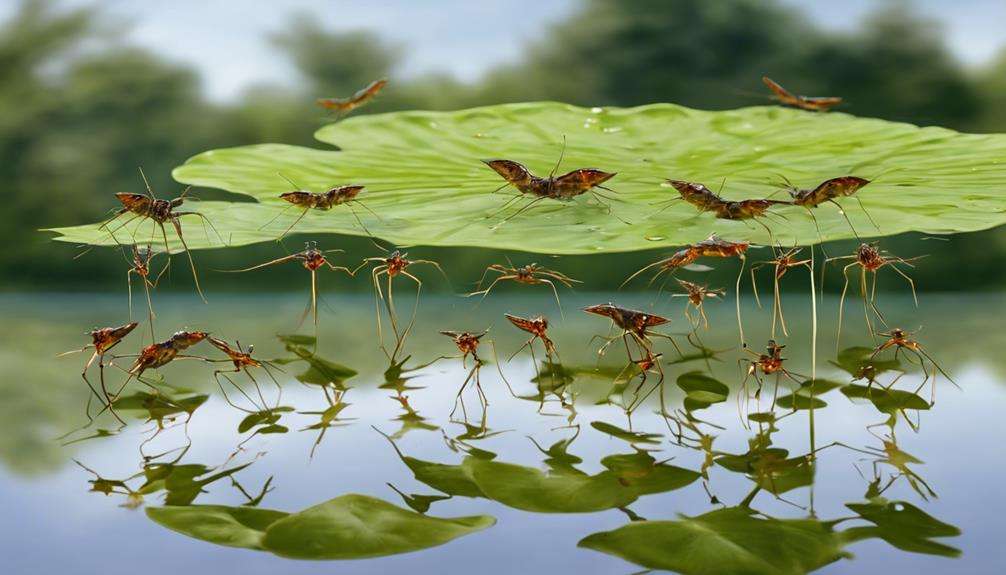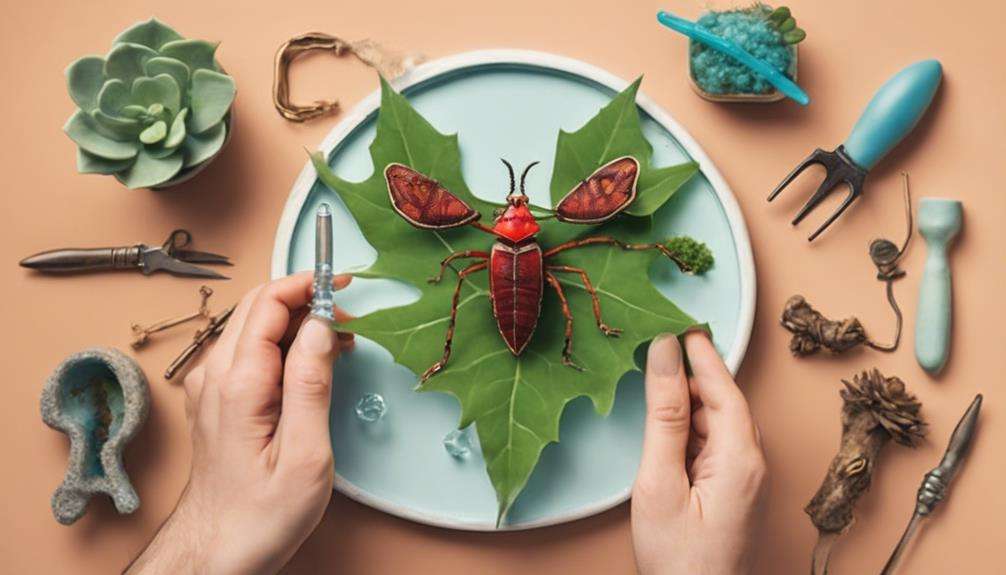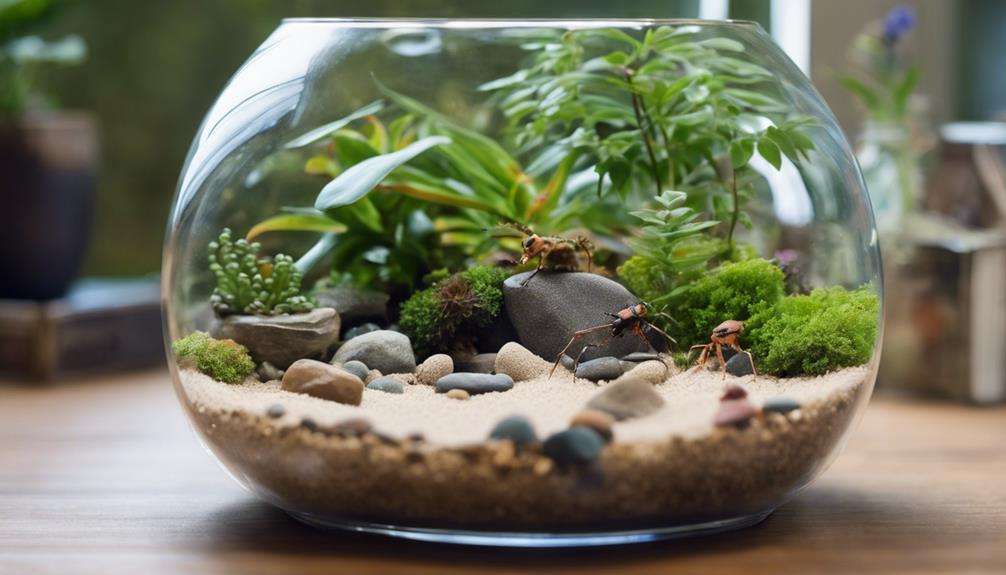Raising pet praying mantises indoors requires attention to detail and a solid understanding of their needs. Ensuring their environment mimics their natural habitat is essential.
But what about the fascinating aspect of their reproductive behavior? This intricate process can both amaze and challenge mantis keepers, leading to a deeper appreciation for these interesting creatures.
Explore the delicate balance of caring for pet mantises and the joys it can bring to your indoor space.
Key Takeaways
- Provide a spacious, well-ventilated habitat with suitable perches and hiding spots.
- Monitor health closely for signs of illness, abnormal behavior, or molting issues.
- Feed a varied diet of live insects, ensuring hydration and occasional supplements.
- Maintain a consistent temperature range of 75-85°F, crucial for growth and moulting success.
Suitable Cages for Indoor Mantises
When considering suitable cages for indoor mantises, clear plastic or glass containers are recommended for younger mantises due to their visibility and containment properties. Ventilation is vital for indoor mantises to prevent stagnant air, so cages should have adequate ventilation holes. This guarantees proper air circulation within the enclosure. To prevent escape, the cages should be secure while still allowing for airflow.
For indoor mantises, the height of the cage is important, with a minimum recommendation of at least twice the length of the mantis. This height provides ample space for the mantis to moult comfortably. Additionally, perches are essential within the cage for safety, moulting, and hunting purposes. These perches should be appropriately sized and positioned to accommodate the mantis' needs.
Choosing the Right Perches
To create a conducive environment for your indoor mantis, selecting appropriate perches plays a critical role in promoting its well-being and natural behaviors. When choosing perches for your pet praying mantis, opt for sturdy options that are wide enough to allow comfortable climbing and resting.
Natural perches such as twigs, branches, or artificial plants can offer a variety of surfaces for your mantis to explore. Make sure that the perches don't have sharp edges or rough textures that could harm your mantis during its activities.
Placing perches at different heights within the enclosure helps create a dynamic environment, encouraging movement and engagement. It's essential to securely attach the perches to guarantee stability and prevent accidents or injuries while your mantis is exploring its habitat.
Importance of Houseplant Spray
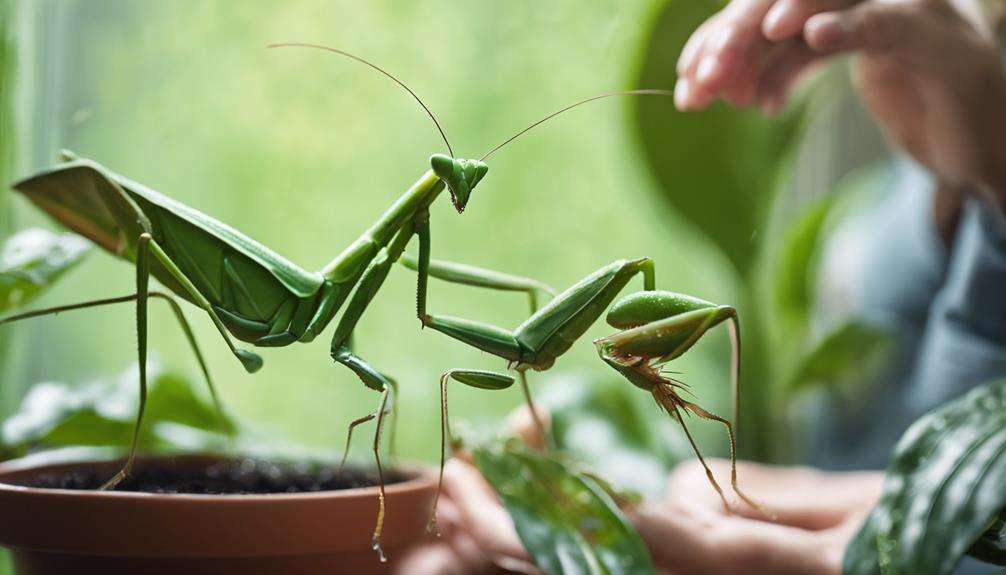
Houseplant spray plays an important role in maintaining the health and well-being of indoor pet praying mantises by mimicking their natural water sources and aiding in essential moulting processes.
In the wild, praying mantises drink water droplets from various surfaces, and houseplant spray replicates this behavior in captivity. Captive mantises rely on appropriate humidity levels to successfully moult, shedding their exoskeleton to grow.
Regularly spraying the cage with houseplant spray guarantees that the mantises have access to drinking water and helps keep them hydrated. This practice is critical for the overall well-being of pet mantises living in an indoor environment.
Providing Adequate Heating
You must guarantee that the temperature in the mantis enclosure remains within the ideal range of 75-85°F (24-29°C) for their survival.
Utilizing heating equipment such as heat lamps or heat mats can assist in maintaining the required warmth.
Regular monitoring and adjustment of the heating source based on the mantis's behavior and activity levels are critical for their overall well-being.
Temperature Requirements
Maintaining a consistent temperature range of 75-85°F (24-29°C) is essential for the best health and activity of pet praying mantises when raising them indoors. Praying mantises are highly sensitive to temperature variations, so it's important to provide them with a stable environment to support their metabolic functions and overall well-being.
Utilizing artificial heating sources such as heat lamps or pads can help achieve and maintain the ideal temperature, especially during colder periods. Rapid changes in temperature should be avoided as they can stress the mantises. Monitoring and regulating the temperature within their enclosure is crucial for successful moulting and overall growth.
Heating Equipment Options
To guarantee ideal health and activity levels for your pet praying mantises when raising them indoors, exploring suitable heating equipment options is essential for maintaining a consistent temperature range of 75-85°F (24-29°C).
Consider using heating pads or heat lamps to provide the necessary warmth within the mantis enclosure. It's important to monitor the temperature regularly, especially for specific mantis species, ensuring it aligns with their requirements.
Avoid direct contact between the heating equipment and the mantises to prevent any potential harm like burns. Utilize a reliable thermometer to accurately measure the temperature and make adjustments to the heating equipment as needed.
Feeding Your Pet Mantises
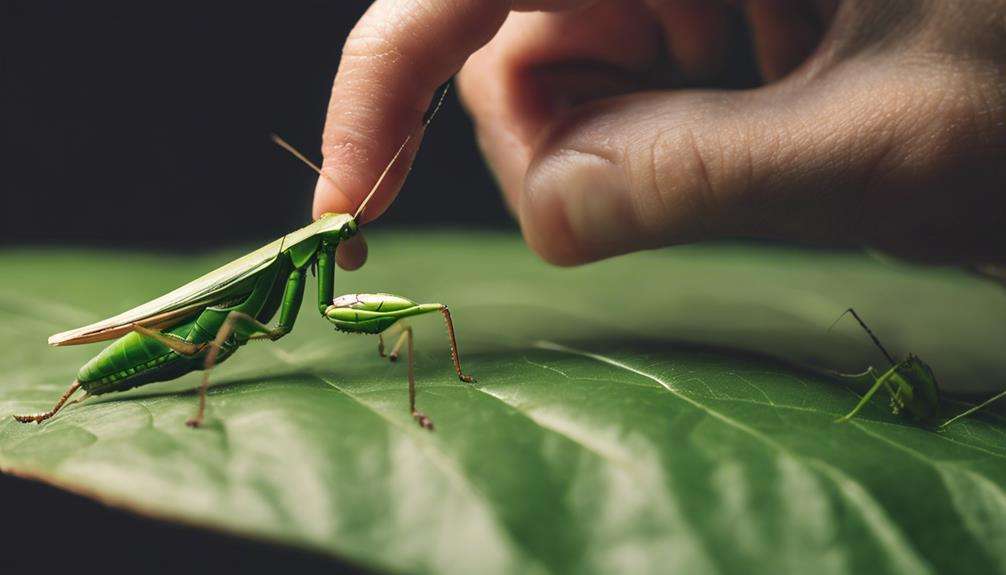
To guarantee the best nutrition of your pet mantises, feed them a variety of live insects such as crickets, locusts, or flies on a daily basis.
Offer prey that's approximately a quarter of the mantis's size to facilitate easy consumption.
Consider gut-loading the insects with nutritious foods before feeding them to your mantises for added health benefits.
Feeding Schedules and Variety
For top nutrition and digestion in your pet mantises, make sure a varied diet of live insects such as crickets, flies, and locusts is provided. Offering feeder insects that are a quarter of the mantis's size helps prevent digestive issues and guarantees easy consumption.
Avoid feeding flying insects to prevent harm or escape, focusing instead on soft-bodied prey for mantis health. Maintaining a consistent feeding schedule is vital to guarantee your pet mantises receive regular nutrition and stay healthy.
Consider using tweezers to offer live insects to your mantises safely and accurately for feeding. By following these guidelines and providing a diverse array of live insects, you can promote the best nutrition and digestive health in your pet mantises.
Live Prey Options
Considering the dietary needs of your pet mantises, selecting suitable live prey options plays an important role in making sure their nutritional requirements are met effectively. Offer soft-bodied live insects such as crickets, flies, and locusts that are about a quarter of the size of your mantises for best nutrition.
Avoid feeding flying insects to prevent harm. Maintain a regular feeding schedule to keep your pet mantises healthy. Using tweezers for feeding aids in portion control and prevents accidents.
Gut-Loading for Nutrition
Start by enriching the nutritional content of prey insects through gut-loading before feeding them to your pet praying mantises.
Gut-loading involves feeding prey insects with nutrient-rich foods like fruits, vegetables, and commercial diets. By doing so, you guarantee that the prey insects are packed with essential vitamins and minerals that are then transferred to your pet mantises.
This process is important for the health and well-being of your pet mantises, as it enhances the nutritional value of their food source. Proper gut-loading provides your pet mantises with the necessary nutrients they require to thrive.
Handling Molted Exoskeletons
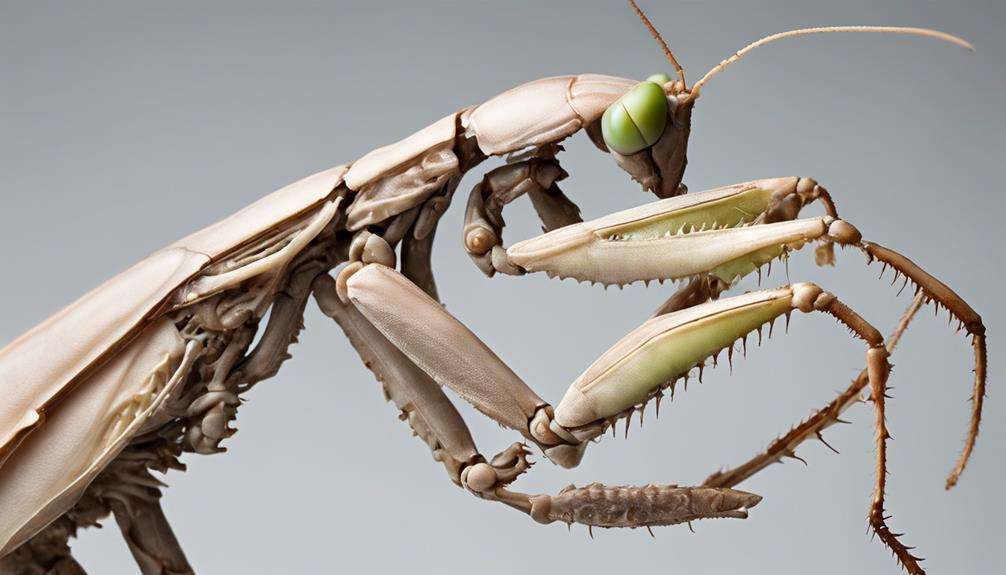
Upon the molting of your pet praying mantis, handling their molted exoskeleton requires careful consideration to support their health and growth. The exoskeleton plays an important role in safeguarding the mantis as it hardens post-molting.
It's advisable not to remove the exoskeleton immediately, as the mantis may still be absorbing essential nutrients from it. Leaving the exoskeleton in the enclosure allows the mantis to consume it, aiding in the intake of calcium and other important nutrients required for its well-being.
In some cases, the mantis may even eat its own exoskeleton to replenish nutrients lost during the molting process. Premature removal of the exoskeleton can induce stress in the mantis, potentially hindering its proper growth and development.
Allowing the mantis to interact with its molted exoskeleton is beneficial for its overall health and ensures a smoother molting process.
Creating a Comfortable Environment
To guarantee the prime well-being of your pet praying mantis, it's essential to create a comfortable environment within its enclosure.
Start by making sure the cage is of adequate size to accommodate the mantis comfortably yet not excessively large, as this may hinder its ability to locate prey. Proper ventilation is important in the enclosure to prevent stagnant air and maintain airflow, which is essential for the mantis's respiratory system.
Providing a suitable perch within the cage allows the mantis to rest, moult, and hunt with ease. Using a houseplant spray can help mimic their natural water source and maintain appropriate humidity levels for their well-being.
It's important to monitor and maintain the temperature in the cage to make sure the mantis remains healthy and active. Additionally, keeping the cage clean and free of uneaten food is necessary to prevent any hygiene-related issues that could affect the mantis's comfort and health.
Monitoring Health and Behavior
Creating a habitat that promotes essential health and behavior in your pet praying mantis is important for its well-being and longevity. To monitor the health of your pet mantis, observe for signs of lethargy, lack of appetite, or abnormal behavior as these could indicate underlying health issues.
Keep a close eye on its eating habits, making sure it consumes prey regularly to maintain its health and vitality. Any changes in color, size, posture, or excessive grooming should be noted, as they may signal stress, illness, or improper environmental conditions. Additionally, watch for erratic movements or difficulties in molting, which may require adjustments to its care.
Regular interaction with your pet mantis is essential to gauge its responsiveness, activity levels, and overall well-being in captivity. By staying attentive to these signs and signals, you can provide the necessary care and attention to make sure your pet praying mantis thrives in its environment.
Frequently Asked Questions
How Do You Keep a Praying Mantis Indoors?
To keep a praying mantis indoors, provide a spacious enclosure with proper ventilation. Maintain temperatures between 75-85°F. Feed live insects like flies. Mist the enclosure for hydration. Maintain regularly. Guarantee climbing surfaces. Monitor molting, behavior, and lifespan. Incorporate enrichment activities.
Do Praying Mantis Make Good House Pets?
Praying mantises are excellent house pets due to their unique behaviors, engaging feeding habits, and low maintenance housing requirements. Their docile temperament, safe handling techniques, and educational value make them a rewarding pet choice indoors.
How Do You Take Care of a Praying Mantis as a Pet?
To take care of a praying mantis as a pet, maintain a feeding schedule with live insects, set up an appropriate enclosure with proper ventilation, handle gently, observe molting process, make sure temperature between 75-85°F, clean regularly, monitor behavior, check health, and provide enrichment activities.
Where Should I Put a Praying Mantis That I Found in My House?
When finding a praying mantis in your house, gently relocate it outdoors to its natural habitat. Guarantee a terrarium setup mimics its environment. Maintain a proper feeding schedule, lighting, and temperature. Avoid handling excessively, monitor humidity, and respect its molting process for top care.
Conclusion
To sum up, raising pet praying mantises indoors requires attention to detail and proper care. Did you know that some species of mantises can rotate their heads up to 180 degrees to spot prey?
By following the tips outlined in this article, you can create a suitable environment for your mantises to thrive and exhibit their fascinating behaviors. Remember to prioritize their well-being and provide them with the necessary resources for a fulfilling life in captivity.
